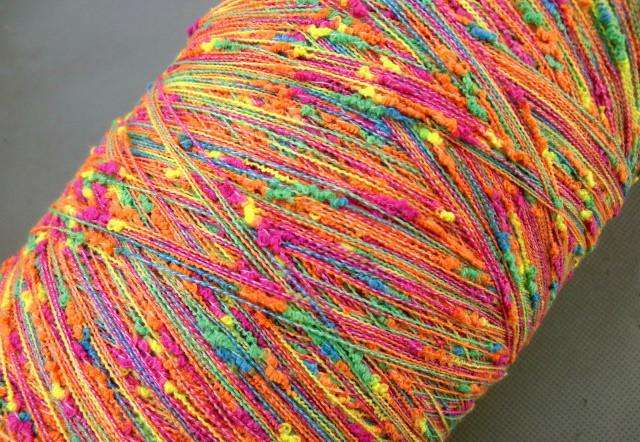Characteristics of Three Color Knot Fancy Yarn
What is the fabric of tricolor yarn?
The characteristics of tricolor knot fancy yarn are that tricolor knot yarn is a web of three colors woven into a single thread, with knots of each color scattered on top of the thread.
For tricolor knot yarn, the yarn count is relatively thick, especially for the knot part. I used a horizontal machine to make the sample. Compared to other types of yarn, colored dot yarn can produce finer yarn counts and can be used for weaving on circular knitting machines. Tri colored knot yarn and colored dot yarn both have many scattered colored dots, but the larger knot yarn is less likely to fall off. In terms of fabric, the three color knot yarn has more diverse colors, but due to the thicker yarn count, it cannot display the softness of colored dot yarn. Overall, tricolor knot yarn and colored dot yarn each have their own beauty and strengths.

A tricolor knot yarn must have a yarn of this color to have knots of this color at the same time. Once a customer came to see us and said they wanted this knot, which is not a variety made separately. If some people like the style of knots with many colors on a single yarn, they can actually test the color dot yarn. Colorful yarn is a yarn with various colors that can be scattered on it, and the size of the colored dots can also be adjusted.
Article source: Fancy Thread Manufacturer
-
05-27
The reason why fabrics containing spandex are prone to yellowing
Spandex is a commonly used fiber variety in our daily lives, characterized by good elasticity, low fineness, high elastic modulus (cracking elongation can reach 400-800), and low specific gravity. Spa
-
04-24
Colored non dyed nylon with synthetic fiber raw material
The current conventional fiber coloring mostly uses yarn dyeing method, which has long process, high loss, high cost, and the product has color difference and low color wash fastness. Yarn is prone to
-
03-26
What are the characteristics of non dyed spandex?
Non dyed spandex has also been widely used in recent years. Non dyed spandex fiber can be blended with fibers such as nylon, polyester, acrylic, cotton, wool, etc., which can give fabrics excellent el
-
02-24
The influence of yarn structure on fabrics
The basic characteristics of yarn include its appearance and shape, twisting characteristics, fiber transfer and distribution characteristics in the yarn, as well as the surface fuzz and internal loos
